Types of Marketing: 45 Strategies + Definitions
Types of Marketing: 45 Strategies + Definitions
By Maggie Aland on January 18, 2017 | Marketing | Comments (6)
Small businesses use different types of marketing to promote their products or services to an audience that they believe will benefit from the offering. There are many different types of marketing that your small business can use. In this article, we will give a definition of the most popular options, and then link to an article with more information on how to apply the marketing strategy to your small business.
Types of Marketing: Online Marketing Strategies
Pay Per Click (PPC) Marketing
This is a fairly new model of internet marketing that was popularized by Google. In this model, advertisers only pay when someone clicks on their ad. This works well for many small businesses since you only have to pay if your ad is actually working to drive traffic to your website. Learn how to set up a PPC campaign on Google. With Bing being the second largest search engine after Google, it’s worth your while to advertise there as well. Click here for a free $50 credit for Bing advertising.
Search Engine Marketing
Get more traffic to your website by paying to advertise on the search engine results page (Google, Bing, Yahoo). With search engine marketing, you can bid on specific keywords so that your ads will show when people search for terms relevant to your business. For example, the website below won the bid for the search term “plumbers nyc.” You only pay when someone clicks on the ad (PPC). Learn how to advertise using Bing ads. Local searches work a bit differently. One of the first steps to ranking in local searches is to build citations for your business, which means making sure your business is accurately listed in as many online directories as possible. Click here to scan your listings with Synup and find out how well your business shows up in local searches.
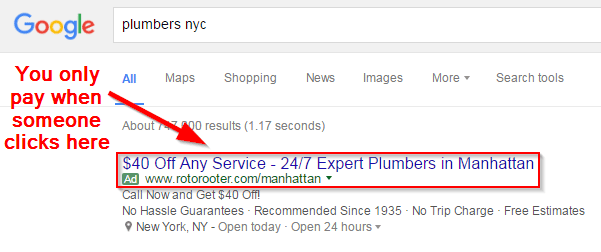
Example of search engine and PPC marketing
Performance Marketing
This refers to online marketing that is driven by performance metrics. Businesses only pay when there are measurable results. The way results are measured can vary, but the most popular types include when a sale is made, a lead is generated, or someone clicks on the ad. Here’s what you should know about performance marketing.
Affiliate Marketing
This is a subset of performance marketing. Find websites that your customers frequently visit, and see if you can pay them to offer your products on their site. It’s a win-win. Your products reach a larger audience, and the website will receive a percentage of the sales. Learn more.
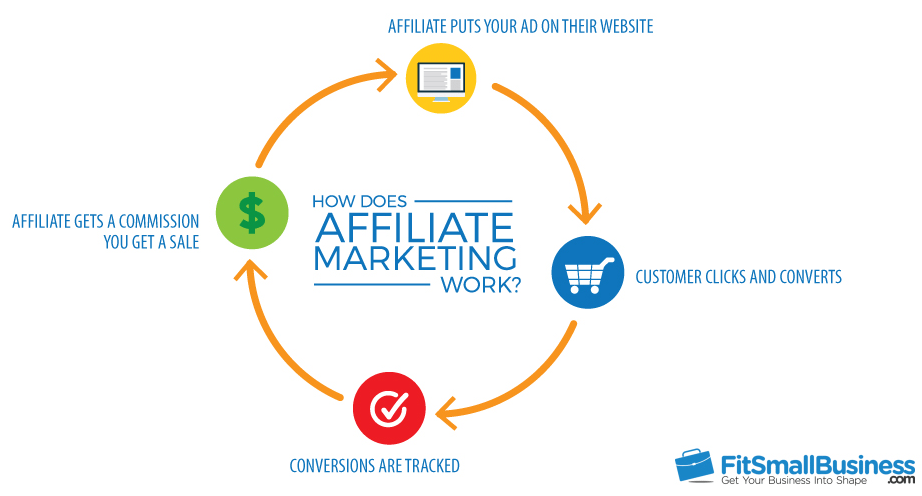
Content Marketing
By producing educational and informative content about topics that are related to your business, it is more likely that potential customers will find your website when using search engines like Google. You can also share the content that demonstrates expertise in your field on social media to attract new customers and spread brand awareness. Content marketing is not a direct pitch for your product, but instead provides value to potential customers so they become familiar with your company. Learn more about how to use content marketing on Facebook.

Example of real estate agent using content marketing on Facebook
Contextual Marketing
Advertise products and services that are most relevant to a user based on their search terms, browsing history, and other information you know about them. This is all about delivering the most relevant content at the time when consumers are most likely to buy. An example of contextual marketing would be if the real estate agent from the example above delivered a “Call for a consultation” ad to people who clicked on his content article. Learn why context is so important with digital marketing.
Inbound Marketing
Inbound marketing uses marketing to bring potential customers to you, rather than having your marketing efforts fight for their attention. This marketing strategy is about creating and sharing content that appeals to your target audience. This turns strangers into customers by attracting prospects to your business. This is the opposite of outbound marketing. Learn more about the 4 inbound marketing actions(attract, convert, close, delight).
Email Marketing
Email is one of the most popular forms of marketing. To send out an email to people who will be interested in your product, you can capture email addresses from your website visitors (with a subscription form), do a cross promotion with another company’s email list, or pay to acquire emails from Facebook or Google. View these email marketing best practices to learn more.
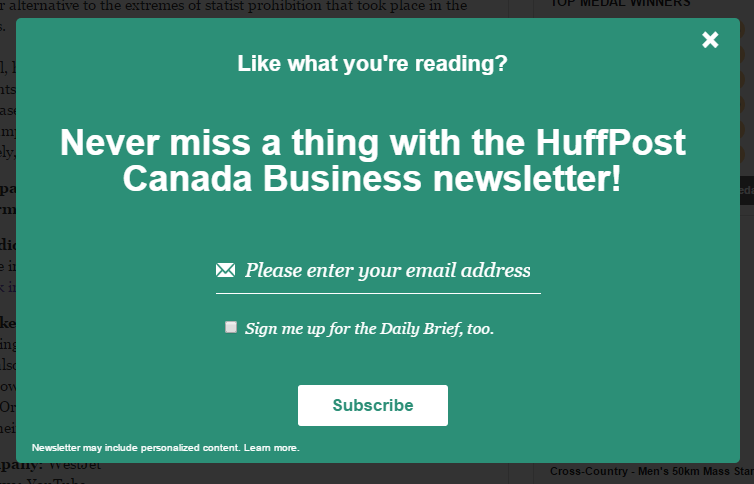
Use a popup on your website to capture email addresses for email marketing
Drip Marketing
Automate your email marketing so that prospects receive a steady flow of marketing based on their interactions with your website and previous marketing efforts. Learn more about how to set up a drip marketing campaign.
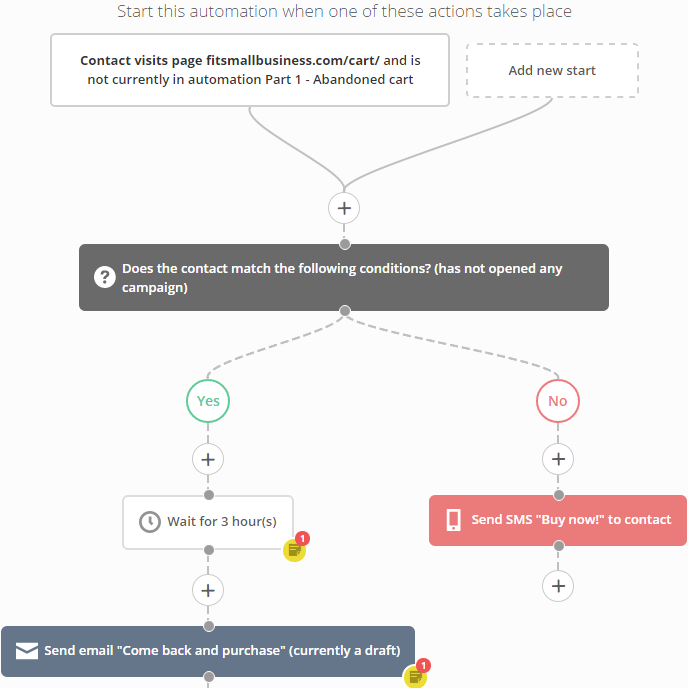
Example of setting up a drip marketing campaign
Interactive Marketing
Also known as trigger-based marketing. This marketing is interactive because your marketing message will change based on the consumer’s actions. For example, Amazon shows its users suggested products based on their search history. Learn how you can benefit from interactive marketing.
Mobile Marketing
Over half of all internet searches are being done from mobile devices, which mean most people are using their mobile devices to make purchasing decisions. Take these 4 mobile marketing steps so you don’t get left behind in today’s digital world.
Re-Marketing
This refers to marketing specifically to people who have previously visited your website. By placing a code on your website, you can tell when someone visits, and then show them ads on other platforms such as Facebook, Twitter, and Google. For example, if you visit an online shoe store, you might notice an ad for the shoe that you were considering buying on the side of your Facebook feed. Learn how to use remarketing on Facebook.

How re-marketing works
Social Media Marketing
Market your business on social media websites such as Twitter, Facebook, YouTube, Pinterest, LinkedIn, Google Plus, Snapchat, and Vine. Social media is becoming a huge platform for businesses to promote their products or services, and the best part is that it’s free to create a social media account for your business. Learn how to set up a business Facebook page to get started.
Database Marketing
Use your database of customer information to craft personalized marketing messages. This information can be stored in a business’s customer relationship management (CRM) software. View our top picks for CRM softwarefor small business.
Proximity Marketing
Uses cell data to send marketing messages to people that are in close proximity to your business and looking to make purchases. Learn how to market to consumers who are close to your business.
Types of Marketing: Offline Marketing Strategies
Direct Mail Marketing
Sending a postcard or letter to a prospect’s mailbox is still a worthwhile, cost-effective form of marketing. Learn how to launch a direct mail campaign.
Event Marketing
Market your small business at an event in order to get face-to-face contact with your target audience. Host and promote your own event in order to get maximum attendees. View these 25 event marketing tips from the pros.
Out of Home (OOH) Marketing
Also known as outside marketing. It refers to reaching customers when they are outside of their homes. Examples include billboards, park benches, taxis, and signage at your store. To learn more about billboard advertising, go here.
Outbound Marketing
This refers to more traditional forms of advertising such as radio, television, trade shows, print ads, and cold calls. The company is the one initiating the conversation and sending out messages to an audience (unlike with inbound marketing). View our offline marketing articles to learn how to advertise using these methods.
Telemarketing
The marketing of goods or services through phone calls, typically through cold calling. View these 25 top cold calling tips to learn more.
Trade Show Marketing
Exhibit your product at an industry specific trade show to get facetime with an audience who is interested in your type of business. View our inventive ideas to help you stand out at a trade show.
Types of Marketing That Can Be Implemented Online and Offline
Guerilla Marketing
A marketing strategy using low-cost and unconventional means to draw attention to a brand locally. This includes spray painting, flash mobs, and sidewalk chalk. View these cost-effective guerilla marketing techniques.

Cross-Media Marketing
Use multiple channels to target a potential customer. By promoting your business in different forms, it’s more likely that the person will remember your brand. You can promote your business through online ads, email, direct mail, and social media. Make sure it’s a coordinated effort; people need to hear about your business multiple times in a short period of time if you want your campaign to be the most effective.
Direct Response Marketing
Ask the audience to respond directly to your marketing. This could be by using a promotion code, answering a phone call, or opting into an email list. This is the opposite of branding which has the goal of spreading awareness of your business, even if no direct action is made. Learn how to increase leads with direct response marketing.
Community Marketing
Engage your existing customers to build a loyal community around your brand. For example, your Facebook fans, Twitter followers, and current client list are all a part of your community. Make sure you are providing them with special offers and deals, and not just focusing on getting new leads. Learn more.
Point of Sale Marketing
This involves marketing to a consumer right as they are making their purchase in order to increase the sale. Examples include placing products at checkout in the grocery store or including a pop-up on your website to see if a customer would like to add on a complimentary product while purchasing products online. Learn how to find a point of sale strategy that works for your business.
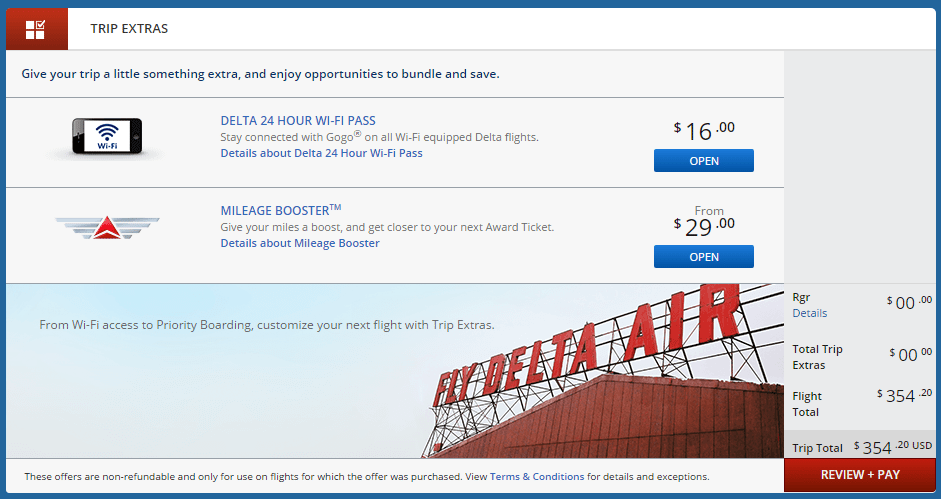
Example of point of sale marketing from Delta
Promotional Marketing
Use of a special offer in order to influence someone to purchase your product. Learn how to use coupons for promotional marketing with our guide.
Pull Marketing
Use tactics such as promoting free content or posting on social media to generate interest in your product and pull in potential customers. View these ingredients for effective pull marketing,
Push Marketing
Push marketing is when you put your products in front of potential customers before they have the desire to purchase. An example would be handing out free samples of your product. Learn some benefits of push marketing.
Referral Marketing
Refers to spreading the word about your business through current customers. Referrals usually happen organically by word of mouth, but companies can use “send to a friend” buttons on their emails or website to spread the word digitally. Offline, businesses can do things like reward customers who refer a friend with a special offer.
Relationship Marketing
Focuses on maintaining customer loyalty by continuing to keep up the relationship with the customer even after the sale has been made. This is aimed at customer retention and satisfaction. An example of this would be sending a Holiday card to your most important customers. Learn about the importance of relationship marketing.
Reverse Marketing
Form of marketing where the consumer seeks out the business. Focuses on building trust by offering help, advice, and relevant information instead of directly pushing a product or service. This works because the ideal customer now views you as the expert in the field. Learn more.
Seasonal Marketing
Tie in upcoming holidays and events to themed promotions and offers. Learn how you can make the most out of seasonal marketing.
Broad Marketing Techniques
Affinity Marketing
Also known as partnership marketing. Find a compatible company with a similar target audience that you can work with. This works to increase the audience who is exposed to your goods or services. An example would be a gym exclusively selling a specific health store’s products, while the health store passes out flyers for the gym. This works well since they are not direct competitors, but have a similar audience. View 7 strategies for affinity marketing success.
Business to Business (B2B) Marketing
If you sell products that are purchased primarily by businesses, you will need to employ B2B marketing. Businesses act differently than individuals, so the marketing tactics differ drastically. It is most important to demonstrate value with this type of marketing. View these B2B marketing tactics.
Business to Consumer (B2C) Marketing
If your products are purchased primarily by individuals, than you will be implementing B2C marketing tactics. You can typically have more fun with this type of marketing, and play on emotional responses rather than just demonstrating value (like in B2B marketing). Here are seven B2C strategies to drive revenue and engagement
Conversational Marketing
Social media is not just a great way to tell people about your business, you can also use the platform to have conversations with your customers. By responding to people’s questions and comments online, you are spreading awareness of your brand and building a relationship with your audience. View the keys to successful conversational marketing campaigns.

JetBlue does a great job of conversational marketing on Twitter
Cross Marketing
Also known as cross promotion. Working with another brand to promote the other’s products to your audience. Sometimes used with social media marketing, where one business will post about another company’s product to their followers for a post about their product in return. Here are 5 ways to integrate cross promotion with online marketing.
Grassroots Marketing
Instead of promoting your message to a large audience, you direct the message to a smaller group and hope that the message will spread. View 50 examples of grassroots marketing campaigns.
Integrated Marketing
Unify your marketing, sales, public relations, and social media efforts to create a seamless experience for consumers interacting with your brand. Learn more.
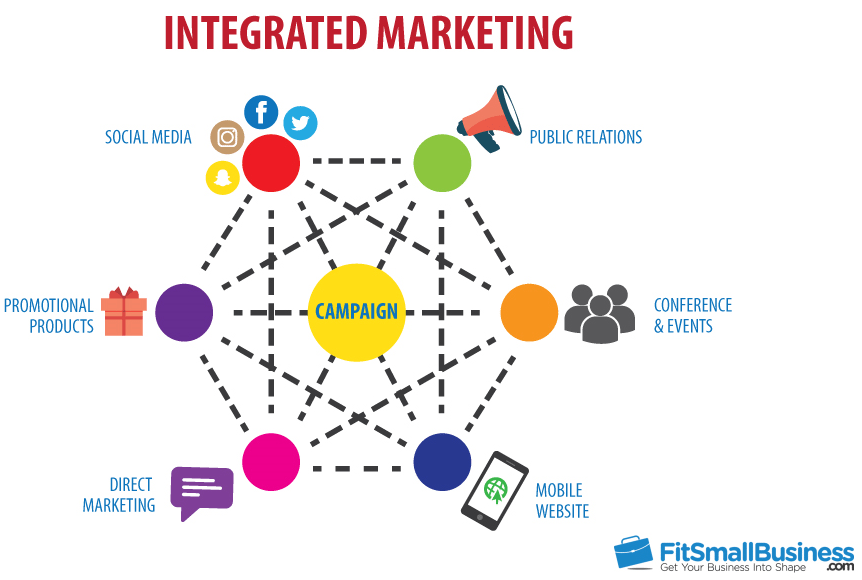
Internal Marketing
Present timely and relevant information to your employees so that they can best sell your goods and services. If the people that work for your small business believe in your product, they will be better equipped to share that knowledge to potential customers. Learn why companies like Disney believe internal marketing is one of the most important forms of marketing.
Niche Marketing
By focusing your marketing efforts on a very specific niche, or target group, you can be a big fish in a small pond. Niche marketing is necessary for specialized businesses. View these 7 niche marketing ideas to learn more.
Permission Marketing
This term is pretty straight forward. Permission marketing is when you get the person’s permission before you market to them. The most popular example of this is when someone opts into an email list. Learn more about permission marketing.
Persuasion Marketing
Persuasion marketing plays on what we know about the human psyche in order to persuade people to make purchasing decisions. A good example of this is how a business designs their website. We know that a person’s eye is more likely to be drawn to a big colored button. You can then use this information to lead sales on your website. View these persuasion marketingtips to learn more.
Product Marketing
Aims to find the perfect customer for a particular product through market research, and then craft an appealing campaign targeted towards that audience. The goal is to ensure success of a specific product. Learn more.
Omni-Channel Marketing
Creating a seamless experience for the customer regardless of the marketing channel used. Delivering a consistent brand experience across your website, brick and mortar store, social media, and other channels. Here’s what you need to know about omni-channel marketing.
Over to You
Are you aware of other types of marketing that we left out of our list? Let us know in the comments below!
Get Our Best Articles Delivered Weekly!
JOIN THE LIST

(Only if you want to improve your small business and get insider advice & tips)
About the Author
Maggie Aland
Maggie Aland is a staff writer for Fit Small Business and editor of the Marketing and Reviews sections. She writes on a variety of marketing topics, ranging from newspaper ads to how to market your business on Facebook. Before joining Fit Small Business, Maggie worked as a marketing associate at a niche publishing company. There she was responsible for determining the marketing plan and keeping up with the budget of 10+ B2B products. Her experience includes email, direct mail, social media, events, and more. When not editing or writing, you can find Maggie looking for the best brunch spots in NYC.
@Maggie_AlandAsk a Question
Comments
Post a Comment